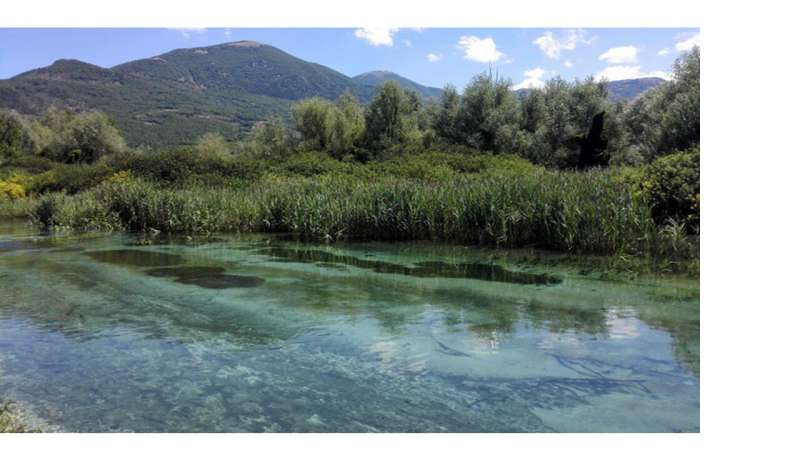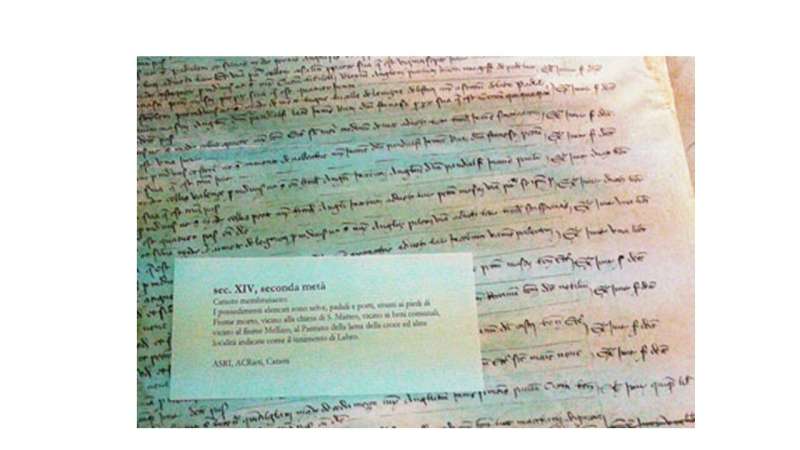Springs and wetland vegetation close to the Nature Reserve of Lago Lungo and Ripa Sottile Rieti. Credit: Gianluca Piovesan
When historians and paleoecologists work directly together to study the past (what is called a consilience-driven approach) we are able to develop much more nuanced explanations for the role of people (or climate) as a cause of past abrupt environmental change. The joint histories of socioeconomic change, developed from archival sources, and ecologic change, reconstructed from pollen analysis of lake sediments, has helped clarify the interrelationship between societal factors and climate forcing in shaping land-use legacies along the Italian Peninsula. We found that different communities, guided by different political and economic structures, created entirely different landscapes, even during periods of similar climate, but after the black plague the rewilding landscape is a common trait in the Apennines
Reconstructing landscape history during Medieval times in Italia peninsula
During the period of Medieval Climate, important differences were revealed in the mountain landscape of the Central Apennines in respect to the Pollino massif. Since the ninth century up to the16th century in the Rieti Basin, consolidation of small landholdings under the church led to larger-scale production of agricultural products and forest clearance. Near Pollino massif, under the same climatic regime, a deforested landscape managed using slash and burn agriculture is present up to the Norman conquest, at which point burning stops and preservation of fir forest for extraction of timbers for construction begins.
The fast recolonization of silver fir forest soon after the expansion of early succession maples and alders is a surprising and interesting process that, however, is forecasted by vegetation dynamics in the absence of human disturbance and finds an analog in today's vegetation dynamics. "This unexpected forest rewilding during the Medieval Climate Anomaly led us to suppose that the spread of fir was a consequence of the abandonment of the land and the protection of seedlings and saplings from fires and from grazing, in the same way today observed inside the strict reserves of Pollino, Sila and Aspromonte National parks," says Gianluca Piovesan from the University of Tuscia.
In both locations, following the black plague and depopulation, the forests shifted to a trajectory of secondary succession and rewilding, a trend observed across most of western Europe. However, the individual pathway of each successional pattern was strongly influenced by human activity prior to land abandonment and local environmental conditions.
Forest rewilding in the Apennines: a process that dates back to late Medieval times
This study confirmed that forest expansion in Mediterranean mountain environments is a fast process. However, following land abandonment, the return to an old-growth state takes centuries. "Considering the intense impact of Medieval society on the Apennines, we hypothesize that most old-growth forest remnants are a landscape legacy of the late Medieval rewilding phase that is still moving closer to a more complex forest ecosystem, as in the case of mountain beech forests or subalpine Heldrich's pine stands," says Gianluca Piovesan, who is coordinating Italian Mountain Lab project for Tuscia University.
Written records in the Rieti State Archive dating back to Medieval times, such as this late medieval document, were compared to pollen diagrams – constructed from cores extracted in high sedimentation lakes - to develop a detailed history of landscape change over time. Credit: University of Tuscia
The combination of paleoecologic, paleoclimatologic and archeological/historical data at the local scale provides a much more nuanced interpretation of causality for abrupt environmental change underlying the central role of human pressures in forest degradation. The demographic collapse after the black pest caused a widespread rewilding, particularly evident in the mountain environment of the central and South Apennines. By linking multiple sites across a region, we have the potential to gain a much deeper understanding of human land-use legacies on forest landscapes.
More information: Mensing, S., Schoolman, E.M., Palli, J. & Piovesan, G. (in press). A consilience-driven approach to land use history in relation to reconstructing forest land use legacies. Landscape Ecol (2020). DOI: 10.1007/s10980-020-01079-5
Provided by University of Tuscia

























